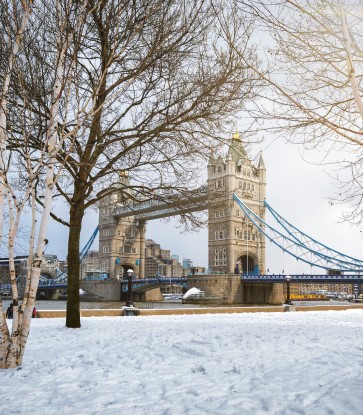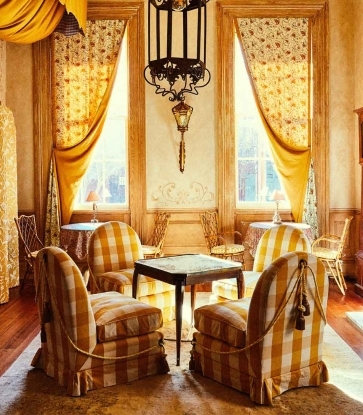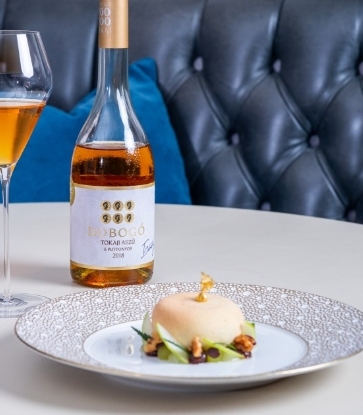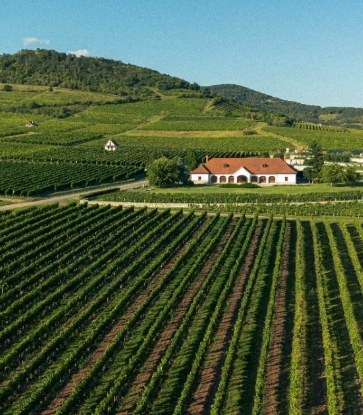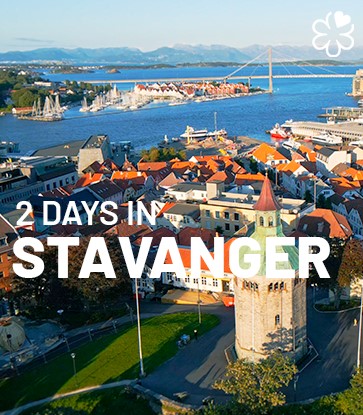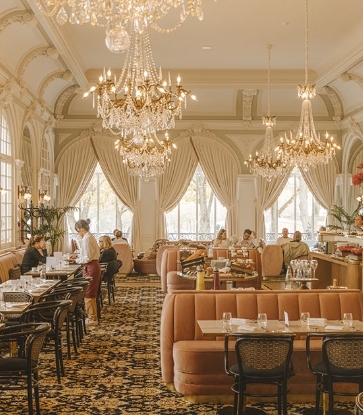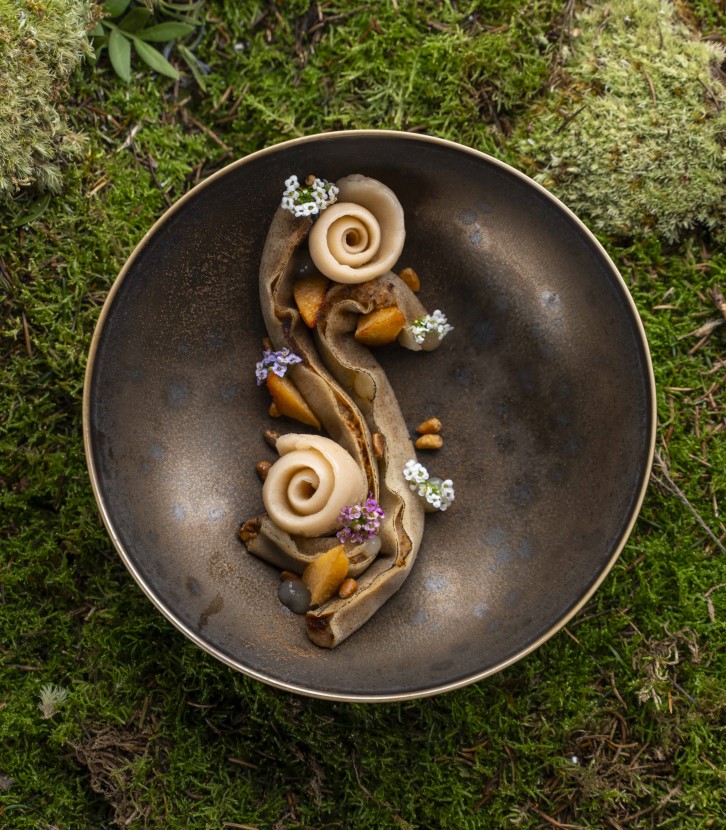There is something distinctly otherworldly about arriving on the Isle of Wight. The crossing is short, but what waits on the other side feels removed from the pace of the mainland. Clifftops curve into the sea and water shifts colour in the space of an afternoon. Inland, sheep graze between crooked oaks and narrow roads tunnel through hedgerows thick with wildflowers. Add to this the island’s bounty of natural produce – from its famous tomatoes to a wealth of delicious seafood – and you have a prime summer holiday destination for any food lover.
Shaped by a remarkably varied coastline for such a small island, the Isle of Wight's beaches differ wildly in character, from broad golden sands to shingle shelves tucked beneath chalk cliffs. Dotted amongst it all are MICHELIN Guide restaurants and hotels to inject high-quality hospitality into your itinerary, no matter what your other activities are. Join us on a tour of the Isle of Wight’s four distinct corners, all offering something a little different – from boutique hotels and sunset views to beach days and culinary delights.

West Coast: The Island on a Plate
If you’re a food lover and only have time to visit one part of the Isle of Wight this summer, make for the west. The island has always known how to feed people well, whether it is a long lunch in the sea air, a supper built around garden-grown vegetables or a wine list curated with purpose. Here, food is influenced as much by sea and soil as by the people cooking it: chefs and restaurateurs who have redefined island dining by letting ingredients speak for themselves.On the western side you have a choice of three top restaurants, all within a short drive of each other near the town of Yarmouth. The Terrace, in the town itself, is a bright harbourside spot that’s ideal for an alfresco lunch. Sit on the terrace with some expertly cooked fish and a glass of white wine – and wonder if life gets any better than this. Stay overnight nearby in The George Hotel, a history-soaked building boasting varied rooms and a terrace that opens straight onto the water.

In nearby Freshwater, The Red Lion offers a different vibe entirely – a traditional village pub with flagstone floors, a log fire and a kitchen rooted in its own garden and nearby farmland. When the weather turns and you need a welcoming refuge, this is the place to come. On sunnier days, head to The Hut, a breezy waterfront spot that’s a key player in the island scene. Boats pull up for rosé-fuelled lunches that turn into dinners, set to the sound of a low-key DJ and clinking glasses.
While you’re in the area, seaside spots to look out for include Compton Bay – broad, untamed and largely untouched, ideal for surfers, bodyboarders and fossil-hunters tracing three-toed dinosaur prints at Hanover Point. Colwell Bay, meanwhile, is known for its clear line of sight across the water to Hurst Castle. Further west, the coastline bristles with defence points and lookout towers. Yarmouth Castle, built under Henry VIII, still guards the mouth of the Solent. The Needles Old Battery is harder to reach and harder to forget; cut into the cliffside and connected by narrow tunnels, it once housed the gunners who guarded the western approach.

North Coast: Boutique Hotels & Country Manors
If the Isle of Wight’s west coast is the prime spot for foodies, then the north is the place to be for hotel and architecture aficionados. Cowes, the maritime town at the head of the island, is home to its only MICHELIN-Key hotel, Foresters Hall. Bringing something different to the area, the hotel was once a meeting hall and later a theatre; it now offers a thoughtful take on what a hotel can be.The owners, both from the film industry, have filled the place with character, drawing on years of travel, design instinct and a strong eye for detail. The building is a lovely Georgian townhouse and many of the period’s design flourishes are on show across the hotel. But so too are dashes of modernity, eye-catching artworks and pops of colour. It all adds up to a beautiful whole.

When it’s time to explore the area, Gurnard Bay is the place to be in the evenings, with front-row views of the Cowes Week regatta and sunsets that light up the Solent. What could be better than basking in golden hour here, nourishing your soul with proper fish & chips? If you’re more of a history buff, then the wonderfully grand Osborne House will see to that. Built by Queen Victoria and Prince Albert as a retreat from London, the house is inspired by the villas of the Italian coast and looks out across the water. Its rooms are rich in detail, while outside the grounds open into sweeping lawns, children’s gardens and, at the water’s edge, the Queen’s private bathing beach.

East Coast: Stunning Coastline and a Big-Name Chef
If you’re wondering where on the north coast to find a top restaurant, your best bet is to head north-east to the seaside town of Ryde. Here, you’ll find RT Café Grill, a restaurant seemingly tailor-made to satisfy holidaymakers on the island’s north or east coasts. The latest venture from renowned chef Robert Thompson, this bistro de luxe will please all-comers. Taking its cues from the classics while incorporating fresh local produce, the menu ranges from caviar to burgers and everything in between – all of which the kitchen team have the skill to pull off.After dining here, you’d be a fool not to explore the island’s eastern edge. Bembridge offers a weathered patchwork of pebbles and tide pools, best explored with coffee in hand after a morning swim. Red-sailed dinghies cut across the harbour, and rockpools at Lane End gleam with sea life when the water pulls back. Yaverland, meanwhile, is a wide, open beach beneath the headland of Culver Down. It’s a favourite for kite surfers, fossil hunters and families who prefer breathing space to arcade noise.

Shanklin is more built up, but worth it, for its old-world beach huts and thatched pubs. If you want to go deeper into history, Brading Roman Villa extends a window into even earlier island life. Its fourth-century mosaics and traces of rural settlements rest beneath a modern canopy, a reminder that this coastline has long been a place not just to pass through, but to put down roots.

South Coast: Crab Pasties & Perfect Weather
The headline attraction for the Isle of Wight’s southern coastline is its microclimate. Due to a combination of factors, this small pocket of the world benefits from gorgeous weather that’s ideal for your summer holiday. Ventnor in particular is a holidaymaker’s dream – and is home to The Crab Shed’s famous crab pasties, a local delicacy that’s perfect for taking down to Steephill Cove. This beach hides below Ventnor, is accessible only on foot and mostly gets swallowed by the tide at high water.Nearby, pay a visit to Ventnor Botanic Gardens. Self-described as “Britain’s hottest garden”, this wonderful array of plant life really makes the most of the microclimate. The island as a whole is great for nature lovers as, despite its size, it has remarkable variety. It is one of the few places in Britain designated a UNESCO Biosphere Reserve, recognised for its ecological diversity and long-standing stewardship of the land.

If you have time, you may also want to venture inland to Carisbrooke Castle, around 25 minutes’ drive from Ventnor. Built soon after the Norman Conquest and later expanded to resist invasions from France and Spain, its stone walls have held off sieges, survived invasions and, most famously, imprisoned King Charles I after the English Civil War. Visitors can explore the quarters, trace the King’s failed escape route and see donkeys raising water from the well-house as they have for generations.
The Isle of Wight is best experienced in moments rather than must-sees: a clifftop path with the sea just visible between trees, lunch that runs long because the light is too good to leave or a castle visit that turns into a history lesson you didn’t expect to enjoy. What makes the island memorable isn’t just the variety (though it has plenty) but how well everything sits together. Food reflects the land. Hotels echo their history. And no matter where you are, the water never feels far.
Hero Image: The Needles, one of the best places to visit during a summer holiday on the Isle of Wight. © Island Visions Photography/iStock





